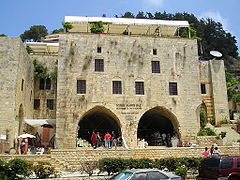Fakhr al-Din II: Difference between revisions
Tobias Homer (talk | contribs) |
Tobias Homer (talk | contribs) mNo edit summary |
||
| Line 37: | Line 37: | ||
==External links== |
==External links== |
||
* [http://countrystudies.us/lebanon/16.htm The Maans] |
* [http://countrystudies.us/lebanon/16.htm The Maans] |
||
* [http://tjgorton.wordpress.com/prince-of-lebanon-a-druze-emir-at-the-court-of-the-medici/] |
|||
{{Authority control|VIAF=9821591}} |
{{Authority control|VIAF=9821591}} |
||
Revision as of 10:09, 4 January 2013
This article needs additional citations for verification. (April 2011) |
| History of Lebanon |
|---|
 |
| Timeline |
|
|
Emir Fakhr-al-Din ibn Maan (1572–April 13, 1635) (Arabic: الامير فخر الدين بن معن), also transliterated Fakhreddine, was a Druze prince and the first leader of the Emirate of Chouf, a self-governed area under the Ottoman Empire between the 17th and 19th centuries. Son of Prince Qorqmaz ibn Maan (Arabic: الامير قرقماز بن معن) and Sit Nasab (Arabic: الست نسب) of the Tanukhi family, he was given the title "Emir" or Prince in Arabic because the Maan dynasty reigned over Lebanon. His period was characterized by economic and cultural prosperity, and he had fought other Lebanese families to unite the people of Lebanon and seek independence from the Ottoman Empire. He is therefore considered by many to be the first "Man of Lebanon" to seek the sovereignty of modern-day Lebanon. However, the Ottomans had discovered his plot and executed him with three of his children on April 13, 1635.

Born in Baakline to a Druze family, he was raised by Sheikh Ibrahim Abou Sakr, a prominent Maronite from the Khazen family, in the Lebanese village of Ballouneh.
In 1608 Fakhr-al-Din forged an alliance with the Italian Grand Duchy of Tuscany. The alliance contained both a public economic section and a secret military one.
Fakhr-al-Din's popularity alarmed the Ottomans who authorized Hafiz Ahmed Pasha, Muhafiz of Damascus, to mount an attack on Lebanon in 1612 in order to reduce Fakhr-al-Din's growing power.
Faced with Hafiz's army of 50,000 men, Fakhr-al-Din chose exile in Tuscany, leaving affairs in the hands of his brother Emir Yunis and his son Emir Ali Beg. Fakhr-al-Din's exile did not prompt the Lebanese army to surrender to Hafiz Ahmed Pasha's army. They maintained their positions while the military operations raged until Emir Yunus managed through negotiations and persuasion to bring an end to the killings, securing the retreat of the Ottoman army.
Hosted in Tuscany by the Medici Family, Fakhr-al-Din was welcomed by the grand duke Cosimo II, who housed him throughout his stay. Fakhr-al-Din had wished to enlist Tuscan assistance in the liberation of Lebanon,[1] but was met with a refusal as Tuscany was unable to afford such an expedition. The prince soon gave up the idea, eventually realizing that such cooperation would only subject Lebanon to a new occupation. His stay nevertheless allowed him to witness Europe's cultural revival in the 17th century.
By 1617, political changes in the Ottoman sultanate had resulted in the removal of many of Fakhr-al-Din's enemies from power, allowing Fahkr-al-Din's return to Lebanon, whereupon he was able quickly to reunite all the lands of Lebanon beyond the boundaries of its mountains; and having revenge from Emir Yusuf Pasha ibn Siyfa, attacking his stronghold in Akkar, destroying his palaces and taking control of his lands, and regaining the territories he had to give up in 1613 in Sidon, Tripoli, Bekaa among others. Under his rule, printing presses were introduced and Jesuit priests and Catholic nuns encouraged to open schools throughout the land.

In 1623, the prince was betrayed by the Harfouch family who made arrangements with Mustafa Pasha, Mirmiran of Damascus, to launch an attack against him, resulting in the battle at Majdel Anjar where Fakhr-al-Din's forces although outnumbered managed to capture Pacha and secure the Lebanese prince and his allies a much needed military victory,and he took over Syria and Palestine from the Turks.
However, as time passed, the Ottomans seemed uncomfortable with the prince's increasing powers and extended relations with Europe. The promise they had made to the Medici family, regarding the Prince of Lebanon, was ignored. In 1632, Kuchuk Ahmed Pasha was named Muhafiz of Damascus, being a rival of Fakhr-al-Din and a friend of Sultan Murad IV, who ordered Kuchuk Ahmed Pasha and the sultanate's navy to attack Lebanon and depose Fakhr-al-Din.
This time, the prince had decided to remain in Lebanon and resist the offensive, but the death of his son Emir Ali Beik in Wadi el-Taym was the beginning of his defeat. He later took refuge in Jezzine's grotto, closely followed by Kuchuk Ahmed Pasha who caught eventually with him and his family.[2]
Fakhr-al-Din was taken to Constantinople and appeared before the sultan. After a trial, Fakhr-al-Din, and three of his sons, were convicted of treason and executed there on 13 April 1635.
After his death, his nephew Ahmed Maan ruled the Shouf heartland of Fakhr ad-Din's former domains. On Ahmed's death in 1697, the Shihab family succeeded the Maans as "Emirs of Mount Lebanon".[3]
Rumors have it that Fakhr-al-Din had secretly adopted the Christian faith. Those rumours, first reported in the Memoirs of Fakhr ad-Din's personal physician, the Dominican Etienne Roger, are not corroborated by any other independent source. [4]
Notes
- ^ Winslow, Charles (1996) Lebanon: war and politics in a fragmented society Psychology Press, New York, page 17, ISBN 978-0-415-14403-2
- ^ Hitti, Philip Khuri (1962) Lebanon in History: From the Earliest Times to the Present (2nd edition) Macmillan, London, page 384, OCLC 758001508
- ^ Abu-Husayn, Abdul-Rahim, Provincial Leaderships in Syria 1575-1650 (Beirut, American University of Beirut Press, 1985)
- ^ Roger, Eugène: La Terre Sainte, ou Description topographique très-particulière des Saints Lieux & de la Terre de Promission… ; Histoire de la vie et mort de l’Emir Fechreddin, Prince des Drus. (Paris, Antoine Bertier, 1674)
